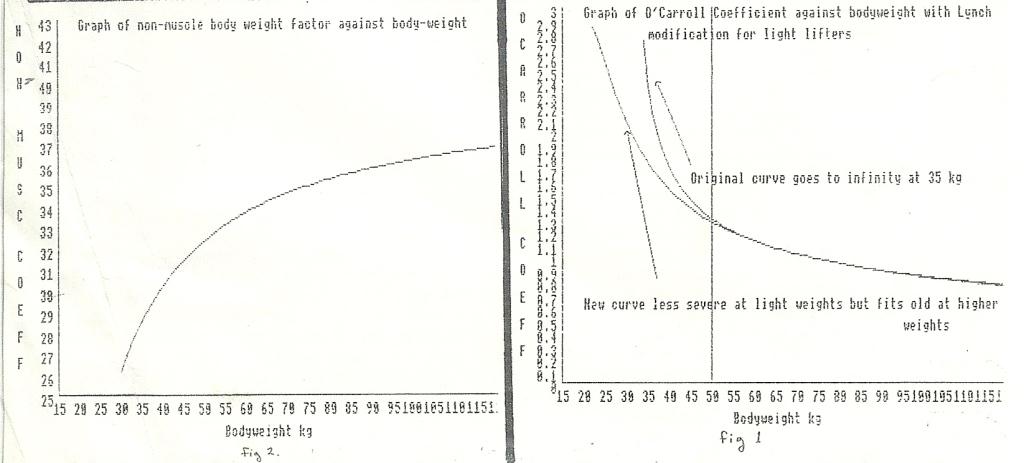(WEBMASTERS COMMENTS: The following story was given to me by Roger Davis some time ago. I just “found it” again as I was cleaning off a portion of my desk looking for something else. As most of you know, the Lynch Formula is the formula we use in the USAWA & IAWA to make the correction adjustments for lifters of different bodyweights. I’m not even sure what publication this article is from, but it does outline the ideas Ian Lynch had when he developed the Lynch Formula. It appears to have been written in 1988, which is about the time we started using the Lynch Formula. I’m still thankful to Roger for keeping this information with the original Lynch Formula so the Lynch Formula Factors could be extended to lifters of higher bodyweights, which we did a couple of years ago. I won’t rehash the fairness of the Lynch Formula at this time. That was covered in depth a couple of years ago, and for those of you interested, those blogs are still on the website. This story should have been ran at that time, but I’m doing it now so it will be saved on the website before I lose this paper again. I know it is a little boring if you are not the mathematical type, and if you don’t want to read all of it that is fine. Come back tomorrow and I promise to have some entertaining “feel good” piece full of fluff by Thom Van Vleck!!)
by Ian Lynch (October 1988)
The O’Carroll Formula is familiar to most Guild members, and is used to handicap lifters of different weights. In devising the Formula, Mike O’Carroll used both statistical and physiological evidence to arrive at a fairly complex mathematical function:
Y + (75 – 35)1/3 / (B – 35)1/3
Y is the O’Carroll coefficient used in tables
75 is to make the coefficient 1.000 at this weight.
B is the assumed weight of the lifter’s “non-muscular” mass, eg. bones, brain, etc.

Lynch Formula Graphs
There are many other Formulas, eg Austin, (the original one used in Britain) Lietzke, Vorobyev and , of course, Schwartz. The strength of the O’Carroll system is that Dr. O’Carroll looked at the physiological reasons to arrive at a basis for the mathematics then cross-referenced this against actual performances to arrive at the constraints, eg. 35 kg. The Formula is tried and tested and was worked out before the drugs era, which is important since it is difficult to say how “Smartie-taking” might change the physiological factors on which the Formula is based.
Unfortunately for the Guild, however, the Formula was designed before even a 52 kg. weight class appeared, and is very unreliable at weights below this. This is because the 35 kg. “non-muscular” component of a person’s body is not, in practice, constant. If it was, anyone weighing 35 kg. would be a totally non-muscular skeleton like me or, in Cookie’s case, a 35 kg. tub of lard, and indeed, no one would weigh less than 35 kg. In the Guild we have opened up competition to more ladies and younger people who, invariably, are lighter than the weight classes provided for by the formula. To combat this I have taken a small liberty with the Formula. Instead of assuming that the non-muscular weight is constant, I have assumed it to be a non-linear function. The particular function was chosen because it means that the final curve produced fits very closely to the O’Carroll curve at greater weights than 52 kg., but at lighter weights produces realistic allowances down as far as we likely to need. See Fig. 1 . There is no deliberate physiological reason for choosing the function I have used other than it fits experience and data so far available. I suspect that there are too many other factors such as age, sex and such like, to arrive at a simple system that is perfectly fair to everyone, but I feel we should make every effort to develop good practice to cater for as many as possible.
For those who like maths, I have replaced the constant 35 by 39.53 – (300/w) – (3000/w^2), in order to preserve the 1.0 coefficient at 75 kg. and modify the curve as illustrated in Fig. 1. Fig. 2 shows how what was previously a value fixed at 35 kg. varies with the weight of the lifter. In practical terms it means that a 40 kg. lifter is assumed to have a non-muscular weight of about 30 kg., a 75 kg. lifter 35 kg. (as in the old system) and a 120 kg. lifter about 37 kg. This marginally helps lifters heavier than 75 kg. and marginally hinders those less than 75 kg. I have stuck to kgs, but it would not be difficult to convert this to pounds if required.
*** Ed’s Note: Curious isn’t it, that someone like Ian who, you must agree, exhibits at the very least a modicum of Intelligence, has a non-muscular constant (head) of 2.25 kg. However, this was mostly bone as brain mass wasn’t discovered and the question was mooted that perhaps he was a Scots Powerlifter. Close. Still, when his teaching days are over he always has his legs to fall back on as those who have enjoyed the dubious pleasure.
Right. now we are even on insults.
Seriously, we cannot thank Ian enough because his expertise will give us a greater platform on which to base the accuracy of our results in the coming years. We have used the O’Carroll Formula in every aspect of our activities and now we will use the”LYNCH FORMULA” with the same degree of confidence and to the same satisfying effect. For the moment – at least – I am only publishing the new figures in Kilos. If it becomes a trial to those applying the new system, then I’ll publish in Imperial Pounds, but I’d prefer if everybody used the metric Kilos from now on – as a matter of course – for uniformity and ease of application

